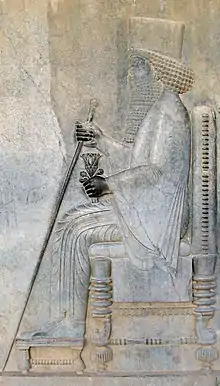Kybernis
Kybernis or Kubernis (ruled 520-480 BCE), also abbreviated KUB on his coins in Lycian, called Cyberniscus son of Sicas by Herodotus, was a dynast of Lycia, at the beginning of the time it was under the domination of the Achaemenid Empire.[1] He is best known through his tomb, the Harpy Tomb, the decorative remains of which are now in the British Museum.[1]

.jpg.webp)
Kybernis is known from Herodotus (Hdt. 7.92, 98) to have served under Xerxes I during the Persian invasion of Greece circa 480 BCE. He came with 50 ships. His men were equipped with cuirasses, felt caps with feathers, and capes made of goat-skin.[2]
The Lycians furnished fifty ships; they wore cuirasses and greaves, carrying bows of cornel-wood and unfeathered arrows and javelins; goat-skins hung from their shoulders, and they wore on their heads caps set about with feathers; daggers they had too, and scimitars. The Lycians were of Cretan descent, and were once called Termilae; they took the name they bear from Lycus, an Athenian, son of Pandion.
Of those that were on shipboard, the most famous, after the admirals, were these: Tetramnestus of Sidon, son of Anysus, Matten of Tyre, son of Siromus, Merbalus of Aradus, son of Agbalus, Syennesis of Cilicia, son of Oromedon, Cyberniscus of Lycia, son of Sicas, Gorgus son of Chersis, and Timonax son of Timagoras, Cyprians both; and of the Carians, Histiaeus son of Tymnes, Pigres son of Hysseldomus, and Damasithymus son of Candaules.
It is assumed that Kybernis disappeared at the Battle of Salamis (480 BCE), together with a large part of the Achaemenid fleet.[5][6]
References
- Mortensen, Eva; Poulsen, Birte (2017). Cityscapes and Monuments of Western Asia Minor: Memories and Identities. Oxbow Books. p. 269. ISBN 9781785708398.
- "A Lycian commander, Kybernis(kos), served under Xerxes in 480 b.c. with fifty ships. His men wore cuirasses and greaves, felt caps with feathers, and goat-skin capes. They were archers and hoplites, carrying javelins, daggers, and curved swords (Hdt. 7.92, 98)." The Cambridge Ancient History: pt. 1. The prehistory of the Balkans; and the Middle East and the Aegean world, tenth to eighth centuries B.C. Cambridge University Press. 1991. p. 659.
- LacusCurtius • Herodotus — Book VII: Chapters 57‑137.
- LacusCurtius • Herodotus — Book VII: Chapters 57‑137.
- Keen, Antony G. (1998). Dynastic Lycia: A Political of History of the Lycians and Their Relations with Foreign Powers : C. 545-362 B.C. BRILL. p. 96. ISBN 9004109560.
- Stafford-Deitsch, Jeremy (2010). Kingdoms of Ruin: The Art and Architectural Splendours of Ancient Turkey. I.B. Tauris. p. 107. ISBN 9781845117993.

